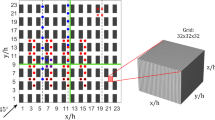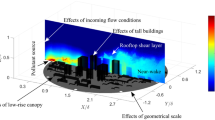Abstract
Spatial and temporal fluctuations in the concentration field from an ensemble of continuous point-source releases in a regular building array are analyzed from data generated by direct numerical simulations. The release is of a passive scalar under conditions of neutral stability. Results are related to the underlying flow structure by contrasting data for an imposed wind direction of \(0{^{\circ }}\) and \(45{^{\circ }}\) relative to the buildings. Furthermore, the effects of distance from the source and vicinity to the plume centreline on the spatial and temporal variability are documented. The general picture that emerges is that this particular geometry splits the flow domain into segments (e.g., “streets” and “intersections”) in each of which the air is, to a first approximation, well mixed. Notable exceptions to this general rule include regions close to the source, near the plume edge, and in unobstructed channels to which the flow is aligned. In the oblique (\(45{^{\circ }})\) case the strongly three-dimensional nature of the flow enhances mixing of a scalar within the canopy leading to reduced temporal and spatial concentration fluctuations within the plume core. These fluctuations are in general larger for the parallel flow (\(0{^{\circ }})\) case, especially so in the long unobstructed channels. Due to the more complex flow structure in the canyon-type streets behind buildings, fluctuations are lower than in the open channels, though still substantially larger than for oblique flow. These results are relevant to the formulation of simple models for dispersion in urban areas and to the quantification of the uncertainties in their predictions.









Similar content being viewed by others
References
Belcher SE, Coceal O, Goulart EV, Rudd AC, Robins AG (2015) Processes controlling dispersion in urban areas. J Fluid Mech 763:51–81
Branford S, Coceal O, Thomas T, Belcher SE (2011) Dispersion of a point source release of a passive scalar through an urban-like array for different wind directions. Boundary-Layer Meteorol 139:367–394
Carpentieri M, Hayden P, Robins A (2012) Wind tunnel measurements of pollutant turbulent fluxes in urban intersections. Atmos Environ 46:669–674
Coceal O, Dobre A, Thomas TG, Belcher SE (2007a) Structure of turbulent flow over regular arrays of cubical roughness. J Fluid Mech 589:375–409
Coceal O, Thomas TG, Belcher SE (2007b) Spatial variability of flow statistics within regular building arrays. Boundary-Layer Meteorol 125:537–552
Coceal O, Thomas TG, Castro IP, Belcher SE (2006) Mean flow and turbulence statistics over groups of urban-like cubical obstacles. Boundary-Layer Meteorol 121:491–519
Coceal O, Goulart EV, Branford S, Thomas TG, Belcher SE (2014) Flow structure and near-field dispersion in arrays of building-like obstacles. J Wind Eng Ind Aerodyn 125:52–68
Davidson MJ, Mylne KR, Jones CD, Phillips JC, Perkins RJ (1995) Plume dispersion through large groups of obstacles a field investigation. Atmos Environ 29:3245–3256
Davidson MJ, Snyder WH, Lawson RE, Hunt JCR (1996) Wind tunnel simulations of plume dispersion through groups of obstacles. Atmos Environ 30:3715–3725
Dobre A, Arnold SJ, Smalley RJ, Boddy JWD, Barlow JF, Tomlin AS, Belcher SE (2005) Flow field measurements in the proximity of an urban intersection in London, UK. Atmos Environ 39:4647–4657
Fackrell JE, Robins AG (1982) Concentration fluctuations and fluxes in plumes from point sources in a turbulent boundary layer. J Fluid Mech 117:1–26
Finn D, Clawson K, Carter R, Rich J, Biltoft C, Leach M (2010) Analysis of urban atmosphere plume concentration fluctuations. Boundary-Layer Meteorol 136:431–456
Goulart EV (2012) Flow and dispersion in urban areas. PhD Thesis, University of Reading, UK
Hamlyn D, Hilderman T, Britter R (2007) A simple network approach to modelling dispersion among large groups of obstacles. Atmos Environ 41(28):5848–5862
Hunt JCR (1985) Turbulent diffusion from sources in complex flows. Annu Rev Fluid Mech 17:447–485
Louka P, Belcher SE, Harrison RG (2000) Coupling between air flow in streets and the well-developed boundary layer aloft. Atmos Environ 34:2613–2621
Soulhac L, Garbero V, Salizzoni P, Mejean P, Perkins R (2009) Flow and dispersion in street intersections. Atmos Environ 43(18):2981–2996
Sykes RI, Henn DS (1992) Large-eddy simulation of concentration fluctuations in a dispersing plume. Atmos Environ 17:3127–3144
Xie Z-T, Hayden P, Voke PR, Robins AG (2004) Large-eddy simulation of dispersion: comparison between elevated source and ground-level source. J Turbul 5:1–23
Xie Z-T, Hayden P, Robins AG, Voke PR (2007) Modelling extreme concentrations from a source in a turbulent flow over a rough wall. Atmos Environ 41:3395–3406
Acknowledgments
Elisa V. Goulart’s PhD was funded by the National Council for Scientific and Technological Development (CNPq), Brazil. Simon Branford was supported by the University of Reading Research Endowment Trust Fund. Omduth Coceal gratefully acknowledges funding from the Natural Environment Research Council (NERC) through their National Centre for Atmospheric Science (NCAS) under Grant no. R8/H12/83/002 and from the Engineering and Physical Sciences Research Council (EPSRC contract number EP/K040707/1).
Conflict of interest
The authors declare that they have no conflict of interest.
Author information
Authors and Affiliations
Corresponding author
Rights and permissions
About this article
Cite this article
Goulart, E.V., Coceal, O., Branford, S. et al. Spatial and Temporal Variability of the Concentration Field from Localized Releases in a Regular Building Array. Boundary-Layer Meteorol 159, 241–257 (2016). https://doi.org/10.1007/s10546-016-0126-0
Received:
Accepted:
Published:
Issue Date:
DOI: https://doi.org/10.1007/s10546-016-0126-0




